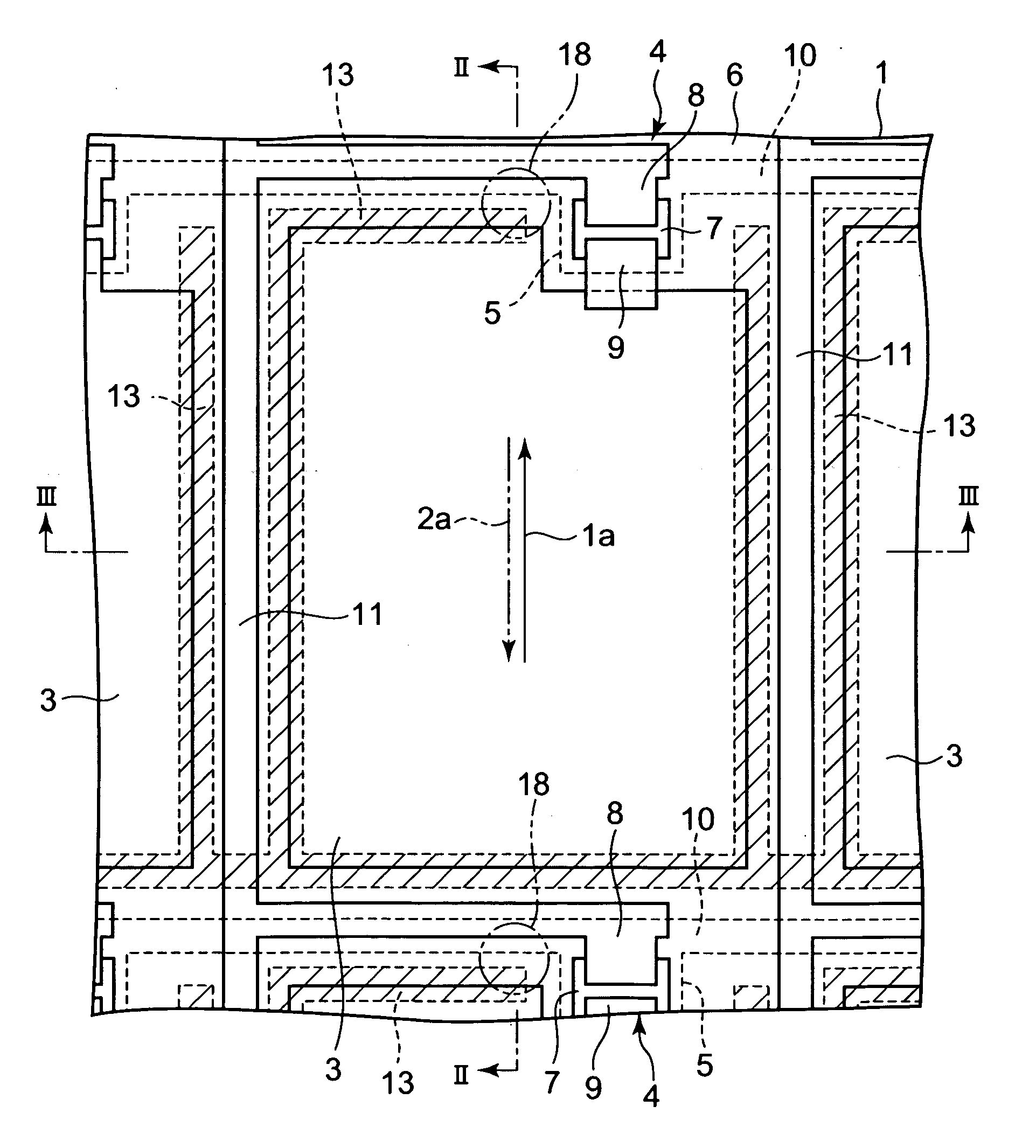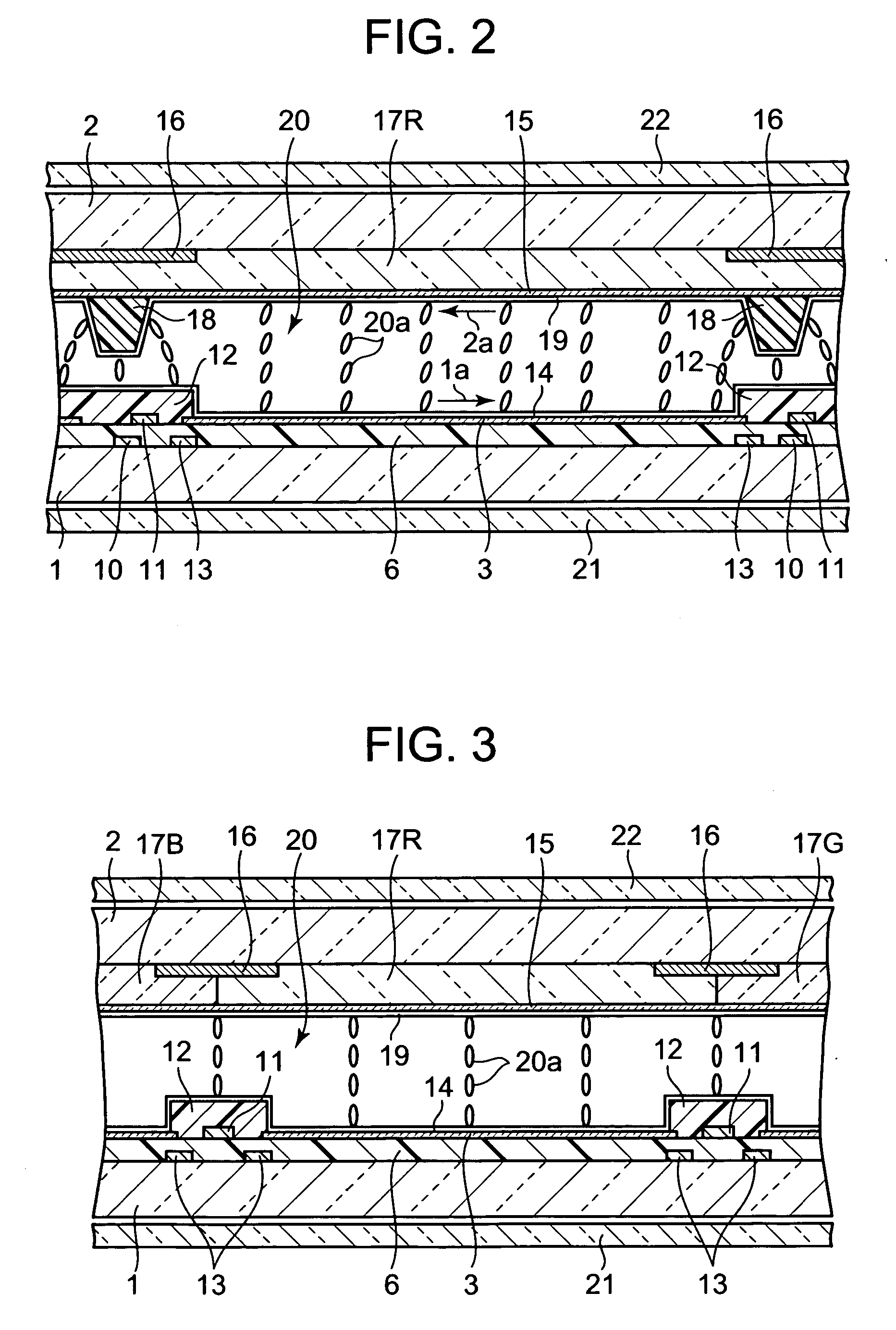Vertical alignment liquid crystal display device
a liquid crystal display and active matrix technology, applied in optics, non-linear optics, instruments, etc., can solve the problems of low aperture ratio and uneven display, and achieve the effect of stable alignmen
- Summary
- Abstract
- Description
- Claims
- Application Information
AI Technical Summary
Benefits of technology
Problems solved by technology
Method used
Image
Examples
first embodiment
[0066]FIG. 1 to FIG. 5 show the first embodiment of the present invention, where FIG. 1 is a plan view of one pixel on one substrate of a liquid crystal display device, and FIG. 2 and FIG. 3 are cross sections of the liquid crystal display device of FIG. 1, as cut along the line II-II and the line III-III respectively.
[0067] The liquid crystal display device is a vertical alignment active matrix liquid crystal display device, and comprises a pair of transparent substrates 1 and 2 opposite to each other with a predetermined gap therebetween as shown in FIG. 1 to FIG. 3. At least one transparent opposing electrode 15 is formed on the inner surface of one substrate of the opposing inner surfaces of the pair of substrates 1 and 2, for example, on the inner surface of the substrate 2 on the viewer side (hereinafter referred to as front substrate). Formed on the inner surface of the other substrate of the opposing inner surfaces of the pair of substrates 1 and 2, i.e., on the inner surfa...
second embodiment
[0101]FIG. 6 is a cross sectional view of one pixel of a liquid crystal display device as the second embodiment of the present invention. In the present embodiment, the components same as those in the first embodiment will be given the same reference numerals, and explanation for such components will be omitted.
[0102] The liquid crystal display device according to the present embodiment has a plurality of protrusions 118 on the inner surface of the front substrate 2 formed to have a predetermined height of protrusion for setting the thickness of the liquid crystal layer to a predetermined one, and has the end of the plurality of protrusions 118 abut on the inner surface of the rear substrate 1 (abut on the overcoat insulation film 12 between the plurality of pixel electrodes 3), thereby defining the gap between the pair of substrates 1 and 2. The structure of the liquid crystal display device of the present invention is the same as that of the liquid crystal display device of the f...
third embodiment
[0104]FIG. 7 is a plan view of one pixel on one substrate of a liquid crystal display device as the third embodiment of the present invention. In the present embodiment, the components same as those in the first embodiment will be given the same reference numerals, and explanation for such components will be omitted.
[0105] The liquid crystal display device according to the present embodiment is not provided with the plurality of protrusions 18 that are provided on the inner surface of the front substrate 2 according to the first embodiment, but has the thin film transistors (TFTs) function as the protrusions 18 in order to stabilize the state of alignment of the liquid crystal molecules by the gate field of the TFTs and the electric field generated between the pixel electrodes 3. Hence, the present liquid crystal display device has each of a plurality of TFTs 41 on the inner surface of the rear substrate 1 positioned at about the center of one edge of each of the pixel electrodes 3...
PUM
| Property | Measurement | Unit |
|---|---|---|
| Fraction | aaaaa | aaaaa |
| Angle | aaaaa | aaaaa |
| Angle | aaaaa | aaaaa |
Abstract
Description
Claims
Application Information
 Login to View More
Login to View More - R&D
- Intellectual Property
- Life Sciences
- Materials
- Tech Scout
- Unparalleled Data Quality
- Higher Quality Content
- 60% Fewer Hallucinations
Browse by: Latest US Patents, China's latest patents, Technical Efficacy Thesaurus, Application Domain, Technology Topic, Popular Technical Reports.
© 2025 PatSnap. All rights reserved.Legal|Privacy policy|Modern Slavery Act Transparency Statement|Sitemap|About US| Contact US: help@patsnap.com



